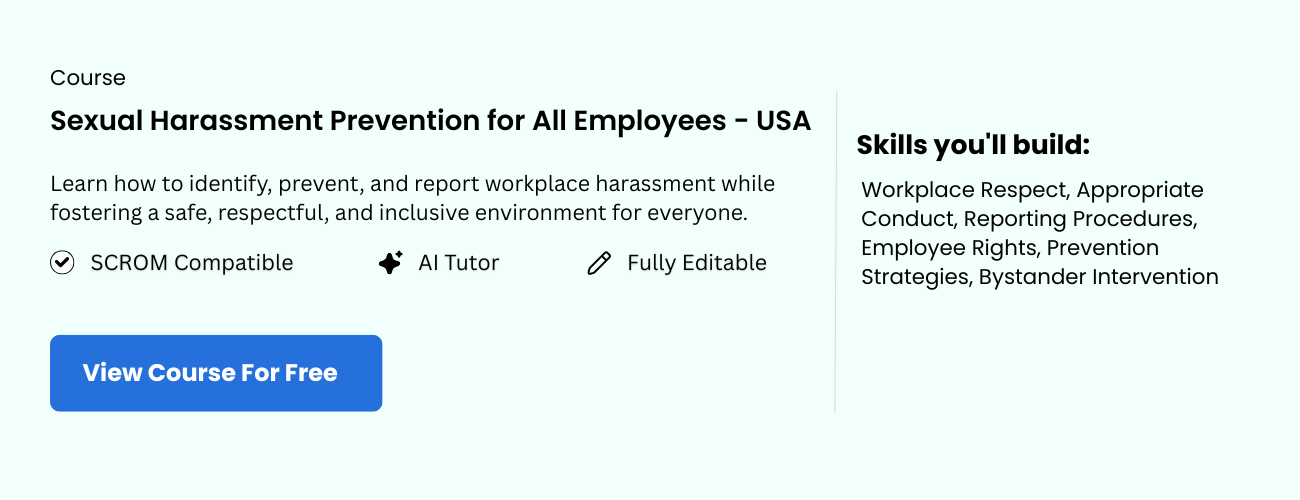Workplace harassment remains one of the most pressing challenges for modern organizations, affecting employee well-being, productivity, and overall workplace culture. As laws grow stricter and workplaces become more diverse and hybrid, employers must take proactive steps to educate their teams and prevent misconduct.
Implementing comprehensive Sexual Harassment Prevention training for All Employees is no longer just a compliance requirement it’s a foundational practice for building safe, respectful, and inclusive environments. This training empowers staff to recognize unacceptable behavior, understand reporting procedures, and contribute to a culture where everyone feels protected and valued. This guide will help you understand what workplace harassment training involves, why it matters, who needs it, and how to implement it effectively for long-term impact.
What Is Workplace Harassment Training?
Workplace harassment training is a structured program designed to educate employees and supervisors about identifying, preventing, and responding to harassment in the workplace. It covers sexual harassment, bullying, discrimination, retaliation, and inappropriate conduct.
The goal is to build a safe, respectful, and inclusive environment where everyone understands their rights and responsibilities.
Why Workplace Harassment Training Is Important
Harassment cases continue to rise worldwide, affecting employee morale, mental health, productivity, and the overall company culture. Training helps organizations minimize risk, reinforce ethical behaviors, and ensure that employees know how to respond appropriately to misconduct.
With stricter national and state-level laws, companies must conduct regular harassment training to stay compliant and avoid penalties.
Types of Workplace Harassment Covered in Training
- Sexual Harassment – unwelcome advances, comments, gestures, or physical contact.
- Verbal Harassment – insults, threats, derogatory language, offensive jokes.
- Physical Harassment – intimidation, assault, blocking movement, or unwanted touching.
- Psychological Harassment – manipulation, humiliation, exclusion, gaslighting.
- Cyber Harassment – online threats, inappropriate messages, digital stalking.
- Discrimination-based Harassment – harassment based on gender, caste, race, religion, disability, age, etc.
What Workplace Harassment Training Should Include
A high-quality training program must educate employees and leaders on:
- The definition and types of harassment
- Real-world examples and case studies
- How to identify early warning signs
- How to report harassment confidentially
- The organization’s investigation process
- Anti-retaliation policies and employee rights
- Supervisor responsibilities and legal consequences
- The company’s code of conduct and behaviour expectations
Legal Requirements for Workplace Harassment Training
Many countries—including the USA, India, UK, Canada, and EU regions—have strict compliance mandates for harassment prevention training.
India
Under the POSH Act, every employer with 10+ employees must train staff on sexual harassment prevention and set up an Internal Committee.
United States
States like California, New York, Illinois, Delaware, and Connecticut require annual or biennial sexual harassment prevention training for supervisors and all employees.
Global Organizations
Multinational companies must follow a combination of international anti-harassment guidelines, company policies, and local labor laws.
Benefits of Workplace Harassment Training
- Promotes a safe, respectful, and professional work environment
- Reduces incidents of harassment and misconduct
- Encourages employees to report issues without fear
- Strengthens workplace culture and teamwork
- Protects employers from legal risks and penalties
- Boosts employee morale and engagement
- Enhances brand reputation and employee trust
How Harassment Training Helps Employees
Employees often hesitate to speak up due to lack of awareness or fear of retaliation. Harassment training educates them about their rights, reporting options, and how the organization ensures confidentiality and fairness during investigations.
It also helps employees understand the difference between acceptable and unacceptable workplace behavior, enabling them to confidently set boundaries and maintain professional interactions. This directly leads to a safer and more empowering work environment.
By fostering a culture of respect and accountability, harassment training reduces conflicts, improves communication, and ensures employees feel valued and protected at work.
How to Implement Workplace Harassment Training
- Identify legal training requirements for your state or country.
- Choose a certified training provider or an online harassment course.
- Train employees and supervisors separately with role-specific content.
- Use real-world examples, quizzes, and scenario-based learning.
- Provide accessible reporting channels for complaints.
- Document attendance and issue completion certificates.
- Conduct refresher training annually for compliance.
Top Workplace Harassment Training Providers
Here are some trusted companies offering high-quality harassment training:
- Paradiso Course Catalog – Offers harassment prevention training, POSH training for employees, custom compliance courses, and an LMS with tracking & reporting.
- Traliant – Known for interactive, bite-sized harassment prevention courses.
- Skillsoft – Provides compliance training for global companies.
- SAI Global – Offers ethics and compliance programs for enterprises.
- Everfi – Delivers workplace safety and harassment training for all industries.
Conclusion
Workplace harassment training is more than just a compliance requirement it’s a foundation for building a safe, respectful, and inclusive work culture. Organisations that invest in regular, high-quality harassment training protect their workforce, strengthen their brand, and create an environment where employees can thrive.
Start today and make your workplace safer for everyone.


























